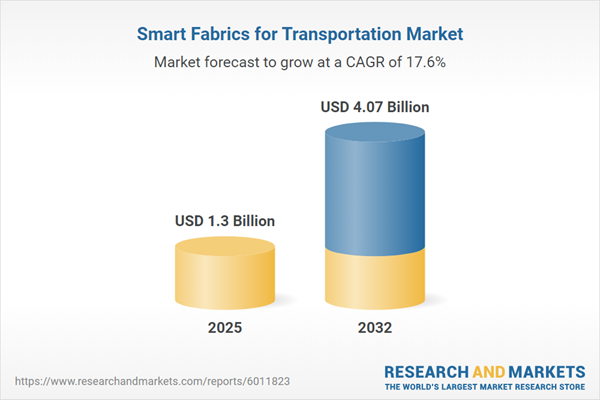Speak directly to the analyst to clarify any post sales queries you may have.
Smart fabrics are reshaping the transportation sector, offering a blend of adaptable, high-performance materials that address evolving industry demands. Senior executives are increasingly evaluating how these advanced textiles underpin next-generation vehicle safety, comfort, and connectivity initiatives.
Market Snapshot: Smart Fabrics for Transportation Market
The Smart Fabrics for Transportation Market grew from USD 1.11 billion in 2024 to USD 1.30 billion in 2025. It is expected to continue growing at a CAGR of 17.61%, reaching USD 4.07 billion by 2032.
This growth reflects a strong shift from proof-of-concept pilots toward widespread adoption across automotive, aerospace, marine, and rail sectors. Adoption is particularly visible where efficiency, sustainability, and regulatory compliance are at the forefront of strategic initiatives. Market expansion is also driven by joint ventures and collaborations among material innovators, OEMs, and electronics specialists to expedite commercialization.
Scope & Segmentation
- Vehicle Types: Aerospace (commercial and military aircraft), commercial vehicles (heavy and light duty), marine (commercial ships, yachts), passenger cars (electric, hybrid, internal combustion), and rail (freight, passenger).
- Application Areas: Communication (wired and wireless), interiors (ambient lighting, touch interfaces), lighting (electroluminescent, LED), safety (collision detection, haptic warning, tire pressure), and seating (heating, massage, ventilation).
- Technologies: Energy harvesting (kinetic, solar), haptic feedback (tactile, vibration), illumination (electroluminescent, LED), sensor integration (health monitoring, pressure, strain), temperature regulation (cooling, heating).
- Material Types: Carbon nanotube-based (multi-walled, single-walled), composites (aramid, glass fiber), metals (copper, stainless steel), and polymers (nylon, PET).
- Fabric Varieties: Conductive (coated, embedded), e-textiles (wired, wireless), smart yarn, and textile sensor-infused types.
- Sales Channels: Aftermarket (online, retail) and OEM partnerships (direct, tier one suppliers).
- Geographical Regions: Americas (including North and Latin America), Europe, Middle East & Africa, Asia-Pacific.
- Key Companies Analyzed: Teijin Limited, Toray Industries, DuPont de Nemours, Huntsman Corporation, 3M Company, Covestro AG, Saudi Basic Industries Corporation, Koninklijke DSM N.V., Hyosung Corporation, Celanese Corporation.
Key Takeaways for Senior Executives
- Smart fabrics are transitioning rapidly from conceptual stages to commercial-scale deployment in major transportation segments. Their real-world applications now include adaptive seating, embedded safety features, and integrated sensor systems.
- Industry convergence between advanced materials and electronics is producing end-to-end solutions that redefine the passenger experience and operational efficiency in vehicles.
- Collaborative development ecosystems, involving textile manufacturers and vehicle OEMs, streamline innovation lifecycle and facilitate faster go-to-market timelines.
- The focus on lightweight composites and carbon nanotube reinforcements is helping achieve both performance gains and sustainability targets, appealing to operators under increasing environmental scrutiny.
- Emerging user interfaces incorporating haptic feedback and smart illumination enable new modalities in passenger and driver interaction, supporting efforts to differentiate vehicle offerings in competitive markets.
Tariff Impact and Supply Chain Shifts
The 2025 United States tariff adjustments on textiles and electronic components have significantly altered industry cost structures and sourcing strategies. Companies are rigorously reassessing supplier networks, adopting nearshoring where feasible, and diversifying procurement to mitigate disruption. These moves are accelerating deeper collaboration between material suppliers, logistics specialists, and integrators seeking agility amid regulatory change.
Research Methodology & Data Sources
This analysis leverages a multi-stage research design, including secondary reviews of patents and standards, primary interviews with technical and procurement professionals, and cross-verification through scenario planning and expert panel validation. Diverse viewpoints were incorporated to ensure balanced, actionable insights relevant to senior leaders in the transportation value chain.
Why This Report Matters
- Enables strategic planning by mapping technology trajectories, material innovations, and cross-sector collaboration dynamics.
- Supports risk mitigation and supply chain resilience initiatives, informed by tariff impacts and global regulatory shifts.
- Equips leadership teams to align R&D, procurement, and sustainability goals for maximum market impact.
Conclusion
Smart fabrics are at the core of a rapidly evolving transportation industry, merging material science and digital innovation. Executives adopting modularity, sustainability, and strong partnerships are well-positioned to define future success in this dynamic field.
Additional Product Information:
- Purchase of this report includes 1 year online access with quarterly updates.
- This report can be updated on request. Please contact our Customer Experience team using the Ask a Question widget on our website.
Table of Contents
3. Executive Summary
4. Market Overview
7. Cumulative Impact of Artificial Intelligence 2025
Companies Mentioned
The companies profiled in this Smart Fabrics for Transportation market report include:- Teijin Limited
- Toray Industries, Inc.
- DuPont de Nemours, Inc.
- Huntsman Corporation
- 3M Company
- Covestro AG
- Saudi Basic Industries Corporation
- Koninklijke DSM N.V.
- Hyosung Corporation
- Celanese Corporation
Table Information
| Report Attribute | Details |
|---|---|
| No. of Pages | 195 |
| Published | October 2025 |
| Forecast Period | 2025 - 2032 |
| Estimated Market Value ( USD | $ 1.3 Billion |
| Forecasted Market Value ( USD | $ 4.07 Billion |
| Compound Annual Growth Rate | 17.6% |
| Regions Covered | Global |
| No. of Companies Mentioned | 11 |









